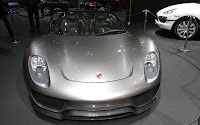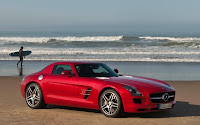
Porsche 918 Spyder
The most significant car NOT at the New York Show? Porsche's 918 Spyder, the undisputed star of the Geneva Salon a few weeks ago. The car's not here in New York because it's en route to the Beijing Show, which opens later this month. That speaks volumes about a seismic shift in focus for the world's auto industry: America is still an important new car market, but it's no longer the world's most important new car market. It also underscores how China's forthcoming vehicle emissions standards, which are planned to be tougher than either U.S. or European standards, are concentrating the minds of the best and the brightest futurists in Weissach.
The plug-in hybrid 918 Spyder, which Porsche says delivers 200 mph performance and 78 mpg on the European fuel economy cycle, is not simply a concept car designed to greenwash Porsche's image at auto shows. Porsche insiders confirm the 918 may in fact go into production, albeit as a very low volume, very high-price flagship model, along the lines of the Carrera GT. "We are convinced the 918 is a car that will be seen in the hands of Porsche customers in the future," insists Porsche R&D chief Wolfgang Durheimer.
"We have delivered the answer to the question from our customers," says Porsche CEO Michael Macht. That question might have been something like this: "Can I drive a supercar and still save the planet?" According to Porsche, you sure can: Not only will the 918 do 200mph; according to Porsche's computer simulations it will reportedly accelerate from 0-60mph in little more than 3.0 sec, and lap the Nurburgring Nordschliefe in 7min 30 sec. And it can go up to 15 miles on electric power alone.
Over at nearby Mercedes-Benz, they're already planning to go one better -- one greener -- than Porsche with a version of the new SLS AMG sports car that will be powered entirely by electric motors. Four of them, to be precise -- one for each wheel -- with a combined output of 536 hp. "We could have more," says one source close to the project, "but horsepower is not the most interesting thing. It's the torque."
Porsche 918 Spyder
At the heart of the SLS eDrive is a 50 kW/hr battery pack that can be recharged in just 25 minutes. The four electric motors are controlled by a sophisticated torque vectoring system that maximizes traction and dramatically improves cornering stability. It has paddleshifters -- not for a transmission, as it has none -- but to allow different levels of regenerative braking on the entrance to corners.
The first SLS eDrive prototypes are already running in Stuttgart. "It's like a super sports car to drive," enthuses our source, who has spent time behind the wheel of one.
The goal is for the SLS eDrive to deliver the acceleration of the 563-hp gas-engined model, which suggests a 0-60 mph time of less than 4.0 sec, something that should easily be achievable with the instant-on grunt of max-thrust-at-zero-revs electric motors. But it's unlikely the car will have the same near-200 mph top speed as the regular SLS. And because even the best batteries are still heavy and relatively inefficient means of storing energy, the SLS eDrive will probably have a fairly limited range -- probably not much more than 125 miles.
Mercedes-Benz SLS
It's not just the eco-friendly symbolism of an electric supercar that's driving the SLS eDrive project, however -- Mercedes-Benz is about to embark on an ambitious program of hybridization, led by the next-generation S-Class and E-Class models, due from 2013 onwards. The company's engineers want to learn all they can about battery technology to ensure Mercedes' forthcoming hybrid powertrains are as efficient as possible. And what better way to stress test them than in an eco-supercar.
Source: http://www.motortrend.com/
























0 comments:
Post a Comment